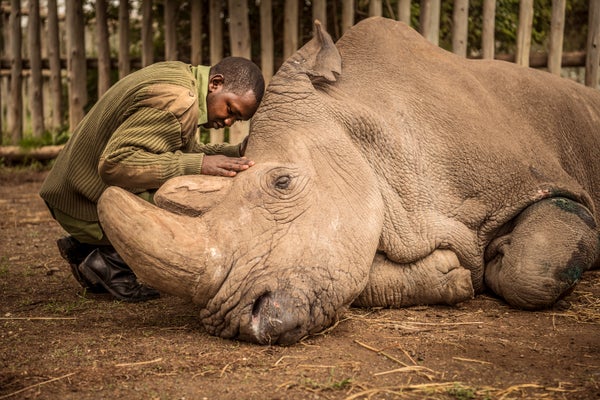On supporting science journalism
If you're enjoying this article, consider supporting our award-winning journalism by subscribing. By purchasing a subscription you are helping to ensure the future of impactful stories about the discoveries and ideas shaping our world today.
Sudan, the world’s last male northern white rhino, died at 45 (elderly in rhino age) Monday at Kenya’s Ol Pejeta Conservancy, about 130 kilometers north of Nairobi. The animal’s health had been deteriorating for the past month and recently worsened so much that he could no longer stand, prompting a decision by his veterinary team to euthanize him. Born in Shambe, South Sudan, the rhino was captured two years after roaming in the wild and brought to the Dvur Králové Zoo in the Czech Republic. He was moved to the Ol Pejeta Conservancy 34 years later.
One of a kind, this majestic, bodyguard-protected beast was beloved by many worldwide—and his death is a grim reminder of humanity’s threat to animals. Poachers in the 20th century wiped out most of this white rhino subspecies (Ceratotherium simum ssp. cottoni) population, mainly for their horns, which were used in traditional Chinese health treatments. More than 2,000 of the animals roamed wild in the 1960s but their numbers had dropped to a couple dozen by the end of the century. The only remaining northern whites today are two captive females—Sudan’s daughter, Najin, and granddaughter, Fatu. Neither is able to produce offspring naturally.
Now researchers are hoping to keep this subspecies alive by artificially fertilizing Najin and Fatu’s eggs with sperm frozen from male northern white rhinos and then implanting the fertilized eggs into a female southern white rhino—a subspecies that was also threatened but has since grown exponentially because of conservation efforts. Last year as part of a campaign to raise money for such in vitro fertilization attempts, which experts say could cost as much as $9 million, Sudan acquired a Tinder account where people can donate money by swiping right. As of late Tuesday the Ol Pejeta Conservatory had yet to update its Web site, which still reads, “Visit the last three northern white rhinos”—a ticking alarm clock to which some humans are desperately trying to add time.
